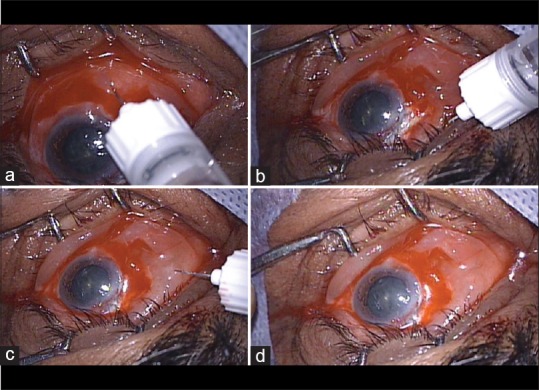Ocular surface squamous neoplasia includes a wide spectrum of premalignant and malignant tumors affecting the elderly, those with immunocompromised status, excessive sun exposure, xeroderma pigmentosa, and cigarette smokers. Management includes excision biopsy, combined with topical chemotherapy, antiviral therapy, and immunomodulation.[1,2,3,4]
A 62-year-old male presented with pain and redness in the left eye of 4 months duration. He reported excision biopsy of conjunctival tumor with amniotic membrane transplant (AMT) in that eye 3 months previously, elsewhere. Histopathological report revealed conjunctival squamous carcinoma in situ with incomplete excision at lateral margins and tumor-free deeper margins.
Discussion
At presentation to us, vision in both eyes was 20/20. The right eye was normal [Fig. 1a]. Left eye showed bulbar conjunctival congestion, absorbing AMT with anchor sutures, an exuberant conjunctival nodule (2 mm × 2 mm), and suspicious of residual conjunctival tumor [Fig. 1b and c]. There was no involvement of the cornea. The patient was treated with intralesional and subconjunctival injection of 10 million units of interferon (IFN) alpha-2b [Fig. 2] followed by topical IFN (1 million units/1 ml) 3 times a day for 6 months. The patient was reviewed at 4 weeks follow-up with a significant reduction of tumor [Fig. 1d], and continued to improve at each monthly visit [Fig. 1d–h]. Topical IFN treatment was stopped at 6 months follow-up. At the last follow-up 1 year from presentation, the left eye remained recurrence-free.
Figure 1.

At presentation, the right eye was normal (a). The Left eye revealed residual ocular surface squamous neoplasia with exuberant conjunctival lesion (arrow) near the nasal limbus (b and c); 10 mIU/1 ml interferon was injected and topical interferon (1 mIU/ml) prescribed for 6 months. One month following injection (d), a significant reduction of the tumor was noted. Two months following injection (e), tumor was completely resolved. Regression was maintained at 4 months (f), 6 months (g), and 1 year following injection (h)
Figure 2.

Technique of interferon injection. Residual ocular surface squamous neoplasia was treated with intralesional and subconjunctival injection of interferon in inferior fornix (a), superior fornix (b), and medial fornix (c) with conjunctival ballooning (d)
Conclusion
Subconjunctival and topical IFN alpha-2b are a useful therapeutic approach to treat incompletely excised conjunctival intraepithelial neoplasia with complete tumor control and minor side effects.[5]
Financial support and sponsorship
Nil.
Conflicts of interest
There are no conflicts of interest.
References
- 1.Shields JA, Shields CL. Eyelid, Conjunctival and Orbital Tumors. An Atlas and Textbook. 3rd ed. Philadelphia, PA: Lippincott Wolters Kluwer; 2016. pp. 283–305. [Google Scholar]
- 2.Karp CL, Galor A, Chhabra S, Barnes SD, Alfonso EC. Subconjunctival/perilesional recombinant interferon α2b for ocular surface squamous neoplasia: A 10-year review. Ophthalmology. 2010;117:2241–6. doi: 10.1016/j.ophtha.2010.03.052. [DOI] [PubMed] [Google Scholar]
- 3.Kim BH, Kim MK, Wee WR, Oh JY. Clinical and pathological characteristics of ocular surface squamous neoplasia in an Asian population. Graefes Arch Clin Exp Ophthalmol. 2013;251:2569–73. doi: 10.1007/s00417-013-2450-0. [DOI] [PubMed] [Google Scholar]
- 4.Yin VT, Merritt HA, Sniegowski M, Esmaeli B. Eyelid and ocular surface carcinoma: Diagnosis and management. Clin Dermatol. 2015;33:159–69. doi: 10.1016/j.clindermatol.2014.10.008. [DOI] [PubMed] [Google Scholar]
- 5.Shields CL, Kaliki S, Kim HJ, Al-Dahmash S, Shah SU, Lally SE, et al. Interferon for ocular surface squamous neoplasia in 81 cases: Outcomes based on the American Joint Committee on Cancer classification. Cornea. 2013;32:248–56. doi: 10.1097/ICO.0b013e3182523f61. [DOI] [PubMed] [Google Scholar]


